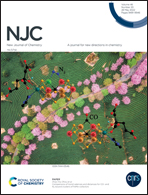Donor–acceptor strategy to construct near infrared AIEgens for cell imaging†
Abstract
Near-infrared (NIR) fluorescence imaging with the merits of deep tissue penetration and high signal to background ratio is widely adopted in disease diagnosis, controlled drug delivery and the in situ and real time monitoring of biological procedures. In particular, the use of aggregation-induced emission luminogens (AIEgens), which feature a large Stokes shift, superior photostability and high brightness, has further expanded the practical application of fluorescence imaging. Here in this article, we utilized 2-(3-oxo-2,3-dihydro-1H-inden-1-ylidene)malononitrile (IC) as the electron acceptor (A) and aromatic aldehydes as the electron donor (D) to fabricate NIR AIEgens. Accordingly, six AIEgens, namely, NIC, 6-MNIC, 6-HNIC, 4-MNIC, DMPIC and DMNIC, were obtained. The photophysical properties plus theoretical calculation results verified that the introduction of D–A interactions successfully redshifted the emission maxima of the obtained AIEgens. DMNIC, with a 4-(dimethylamino)naphthalen-1-yl group as the electron donor moiety, exhibited the longest emission maximum at 694 nm in pure DMSO. The low cytotoxicity and good cell imaging ability toward HeLa cells further guaranteed that DMNIC would provide good prospects for future applications in chemo/biosensing, disease theranostics or diagnosis, controlled drug delivery and release, and deep tissue imaging.



 Please wait while we load your content...
Please wait while we load your content...